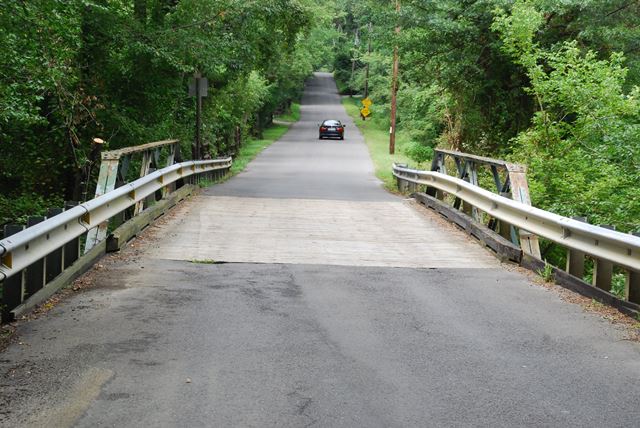We Recommend:
Bach Steel - Experts at historic truss bridge restoration.
BridgeHunter.com Phase 1 is released to the public! - Visit Now
Meirs Road Bridge

Primary Photographer(s): Elaine Deutsch
Bridge Documented: August 18, 2013
Rural: Monmouth County, New Jersey: United States
By Builder/Contractor: Unknown
1991
14.0 Feet (4.3 Meters)
42.0 Feet (12.8 Meters)
15 Feet (4.57 Meters)
1 Main Span(s)
1300U26

View Information About HSR Ratings
Bridge Documentation
View Archived National Bridge Inventory Report - Has Additional Details and Evaluation
This is a small pony truss bridge that likely dates to the early 20th century. Bridges like this where paired angles were the main type of built-up beam on the truss were usually built between 1900 and 1915. Like a number of truss bridges in this area, this bridge has had bents added that support the load of traffic these days, rendering the trusses non-functional.
Information and Findings From New Jersey's Historic Bridge InventoryDiscussion of Bridge Physical Description: The bridge is a 3-panel rivet-connected Warren pony truss. It measures 42'-long and 15.9'-wide, and is composed of standard rolled steel members. The upper chords, lower chords, and diagonals are all composed of riveted steel angles with gusset plates. The flooring system consists of I-beam floor beams, steel stringers reinforced with timber stringers, and a wood plank deck with an asphalt wearing surface. The bridge has outriggers with welded connections at the top chords and floor beams. They appear to be original elements that have been reconnected. The abutments are masonry with concrete repairs. The bridge has been underpinned with three timber pile bents supporting each floor beam. New 4x12 timber stringers have been added. They are deeper than the steel stringers, so the new timber stringers bearing on the floor beams and the abutments are what carry the live loads. The original railings have been removed and replaced with beam guide rails. Historical and Technological Significance: The ca. 1915 Smith Mill Road Warren pony truss bridge is a standard design of its type with no distinguishing construction details, and it has been altered. While the trusses themselves appear to be complete, the placement of piles to support the floor beams (underpinning) and the addition of timber stringers to carry the deck and live load have functionally changed the span from a truss bridge to a stringer. The original design of the undistinguished bridge has been altered. The county engineer's files offered no records of the Smith Mill Road bridge builder or date of construction nor any plans. The lack of documentation further detracts from its historic value. The bridge's style of construction suggests that it dates from ca. 1915. A 1948 inspection report lists the bridge in "poor condition." It is probable that shortly thereafter the truss was underpinned, a common practice in Monmouth County. In the last forty years the bridge's setting has changed from rural to suburban residential. The bridge is one of four Warren trusses in the county (130MT21, Locust Ave. over Claypit Creek, c.1910, Middletown Twp.; 1300A23, Creamery Road over Yellow Brook, c. 1910, Colts Neck Twp.; 1300U23, Harvey Road over Miry Run, Upper Freehold Twp.). A review of old plans and photographs located in the county engineer's office revealed that Warren pony truss bridges were common in Monmouth County. The multi-span Locust Ave. bridge (130MT21) is the most technologically distinguished of the surviving bridges of this type and design. Discussion of Surrounding Area The 3-panel rivet-connected Warren pony truss with concrete-capped masonry abutments was underpinned at each floor beam ca. 1950. Timber stringers bearing on the original floor beams have been added, and the bridge now functions as a 3-span stringer rather than a truss bridge. No bridge plans survive at the county engineer's office. An altered example of a well represented bridge type in the area, the undocumented span has no distinguishing details nor historical associations. Bridge Considered Historic By Survey: No |
![]()
Photo Galleries and Videos: Meirs Road Bridge
Bridge Photo-Documentation
Original / Full Size PhotosA collection of overview and detail photos. This gallery offers photos in the highest available resolution and file size in a touch-friendly popup viewer.
Alternatively, Browse Without Using Viewer
![]()
Bridge Photo-Documentation
Mobile Optimized PhotosA collection of overview and detail photos. This gallery features data-friendly, fast-loading photos in a touch-friendly popup viewer.
Alternatively, Browse Without Using Viewer
![]()
Maps and Links: Meirs Road Bridge
Coordinates (Latitude, Longitude):
Search For Additional Bridge Listings:
Bridgehunter.com: View listed bridges within 0.5 miles (0.8 kilometers) of this bridge.
Bridgehunter.com: View listed bridges within 10 miles (16 kilometers) of this bridge.
Additional Maps:
Google Streetview (If Available)
GeoHack (Additional Links and Coordinates)
Apple Maps (Via DuckDuckGo Search)
Apple Maps (Apple devices only)
Android: Open Location In Your Map or GPS App
Flickr Gallery (Find Nearby Photos)
Wikimedia Commons (Find Nearby Photos)
Directions Via Sygic For Android
Directions Via Sygic For iOS and Android Dolphin Browser
USGS National Map (United States Only)
Historical USGS Topo Maps (United States Only)
Historic Aerials (United States Only)
CalTopo Maps (United States Only)

